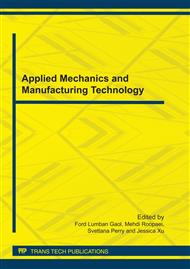[1]
R. Villalobosa, P. Herna´ndez-Mun˜ozb and A. Chiraltc: Food Hydrocolloids Vol. 20 (2006), p.502–509.
Google Scholar
[2]
M.A. Rojas-Grau¨, R. Soliva-Fortuny and O. Martı´n-Belloso: Trends in Food Science and Technology Vol. 20 (2009), pp.438-447.
DOI: 10.1016/j.tifs.2009.05.002
Google Scholar
[3]
C.M.B.S. Pintado, M.A.S.S. Ferreira and I. Sousa: Food Control Vol. 21 (2010), pp.240-246.
Google Scholar
[4]
P. Herna´ndez-Mun˜oz, R. Villalobos and A. Chiralt: Food Hydrocolloids Vol. 18 (2004), p.647–654.
Google Scholar
[5]
P.Y. Hamaguchi, W.Y. Weng and M. Tanaka: Food Chemistry Vol. 100 (2007), p.914–920.
Google Scholar
[6]
J. N. Coupland, N.B. Shaw, F.J. Monahan, E.D. O'Riordan and M. O'Sullivan: Journal of Food Engineering Vol. 43 (2000), pp.25-30.
Google Scholar
[7]
P.J.A. Sobral, J.S. Santos and F.T. Garcı´a: Food Engineering Vol. 70 (2005), p.93–100.
Google Scholar
[8]
B. Bravin, D. Peressini and A. Sensidoni: Journal of Food Engineering Vol. 76 (2006), p.280–290.
Google Scholar
[9]
E. Ayranci and S. Tunc: Food Chemistry Vol. 72 (2001), pp.231-236.
Google Scholar
[10]
Y.Y. Li, X.L. Guo, P.F. Lin, C.C. Fan and Y.S. Song: Carbohydrate Polymers Vol. 81 (2001), pp.484-490.
Google Scholar
[11]
L. Sa'nchez-Gonza'lez, M. Vargas, C. Gonza' lez-Martı'nez, A. Chiralt and M. Cha'fer: Food Hydrocolloids Vol. 23 (2009), pp.2102-2109.
Google Scholar
[12]
G.A. Denavi, M. Pe´rez-Mateos, M.C. An˜o´n, P. Montero, A.N. Mauri and M.C. Go´ mez-Guille´n: Food Hydrocolloids Vol. 23 (2009), p.2094–2101.
DOI: 10.1016/j.foodhyd.2009.03.007
Google Scholar
[13]
F.M. Monedero, M.J. Fabra, P. Talens and A. Chiralt: Journal of Food Engineering Vol. 97 (2010), p.228–234.
Google Scholar
[14]
B.E. Dybowska: Food Engineering Vol. 104 (2011), pp.81-88.
Google Scholar
[15]
J. Osés, M.F. Vázquez, R.P. Islas, S.A. Tomás, A.C. Orea and J.I. Maté: Journal of Food Engineering Vol. 92 (2009), pp.56-62.
DOI: 10.1016/j.jfoodeng.2008.10.029
Google Scholar
[16]
K.G. Zinoviadou, K.P. Koutsoumanis and C.G. Biliaderis: Food Hydrocolloids Vol. 24 (2010), p.49–59.
Google Scholar
[17]
M.J. Fabra, P. Talens and A. Chiralt: Journal of Food Engineering Vol. 85 (2008), p.393–400.
Google Scholar
[18]
M.J. Fabra, A. Hambleton, P. Talens, F. Debeaufort and A. Chiralt: submitted to Journal of Food Hydrocolloids (2011). Doi: 10. 1016/j. foodhyd. 2011. 01. 012.
DOI: 10.1016/j.foodhyd.2011.01.012
Google Scholar
[19]
E. Kristo, K.P. Koutsoumanis and C.G. Biliaderis: Food Hydrocolloids Vol. 22 (2008), pp.373-386.
Google Scholar
[20]
L.J. Pan and J.Q. Chen: Experimental Design and Data Processing (Southeast University Press, Nanjing, China 2008).
Google Scholar
[21]
Y.Z. Liang, K.T. Fang and Q.S. Xu: Chemometrics and Intelligent Laboratory Systems Vol. 58 (2001), p.43–57.
Google Scholar
[22]
S.P. Ma, L.Y. Jiang and B.Y. Ma: Transactions of the CSAE Vol. 24 (2008), pp.29-33.
Google Scholar
[23]
X.H. Zhao: Food Research and development Vol. 29 (2008), pp.23-26.
Google Scholar
[24]
ASTM, 2009. Designation: D 882 – 09: Standard Test Method for Tensile Properties of Thin Plastic Sheeting.
Google Scholar
[25]
ASTM D1003-61, 1997: Standard Test Method for Haze and Luminous Transmittance of Transparent Plastics.
Google Scholar
[26]
J.W. Rhim: Lebensmittel-Wissenschaft und-Technologie Vol. 37 (2004), P. 323-330.
Google Scholar
[27]
ASTM, 2009. Designation: 1434 – 82: Standard Test Method for Determining Gas Permeability Characteristics of Plastic Film and Sheeting.
Google Scholar
[28]
ASTM E-398, 2003: Standard Test Method for Water Vapor Transmission Rate of Sheet Materials Using Dynamic Relative Humidity Measurement.
DOI: 10.1520/e0398-20
Google Scholar
[29]
J.H. Zhang: Food Packing (China Agricultural Press, Beijing, China, 2002).
Google Scholar
[30]
M. Schou, A. Longares, C. Montesinos-Herrero, F.J. Monahan, D. O'Riordan and M. O'Sullivan: Food Science and Technology Vol. 38 (2005), p.605–610.
DOI: 10.1016/j.lwt.2004.08.009
Google Scholar
[31]
M.B. Perez-Gago and J.M. Krochta: Agricultural and Food Chemistry Vol. 48 (2000), p.2687–2692.
Google Scholar
[32]
R. Villalobos, J. Chanona, P. Hernández, G. Gutiérrez and A. Chiralt: Food Hydrocolloids Vol. 19 (2005), pp.53-61.
DOI: 10.1016/j.foodhyd.2004.04.014
Google Scholar
[33]
M.J. Fabra, P. Talens and A. Chiralt: Journal of Food Engineering Vol. 96 (2010), pp.356-364.
Google Scholar
[34]
B.W.S. Souza, M.A. Cerqueira, A. Casariego, A.M.P. Lima, J.A. Teixeira and A.A. Vicente: Food Hydrocolloids Vol. 23 (2009), p.2110–2115.
DOI: 10.1016/j.foodhyd.2009.03.021
Google Scholar
[35]
P. Herna´ndez-Mun˜oz, R. Villalobos, and A. Chiralt: Food Hydrocolloids Vol. 18 (2004), p.403–411.
Google Scholar
[36]
M. Ozdemir, J.D. Floros: Journal of Food Engineering Vol. 86 (2008), p.215–224.
Google Scholar
[37]
M.E. Gounga, S.Y. Xu and Z. Wang: Journal of Food Engineering Vol. 83 (2007), p.521–530.
Google Scholar
[38]
M. Schou, A. Longares, C.M. Herrero, F.J. Monahan, D.O. Riordan and O. Sullivan: Food Science and Technology Vol. 38 (2005), p.605–610.
Google Scholar
[39]
N.B. Shaw, F.J. Monahan, E.D. O'Riordan, M. O'Sullivan: Journal of Food Engineering Vol. 51 (2002), p.299–304.
Google Scholar
[40]
I. Bodnar, A. C. Alting and M. Verschueren: Food Hydrocolloids Vol. 21 (2007), p.889–895.
Google Scholar
[41]
J. Ose' s, I. Fernandez-Pan, M. Mendoza and J. I. Mate': Food Hydrocolloids Vol. 23 (2009), pp.125-131.
Google Scholar
[42]
F. Tihminlioglu, I. Atik and B. Ozen: Journal of Food Engineering Vol. 96 (2006), p.342–347.
Google Scholar


